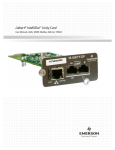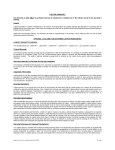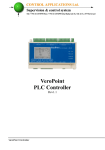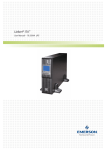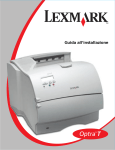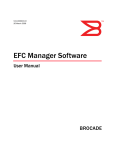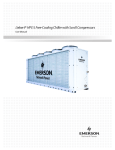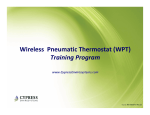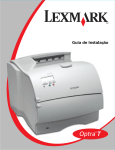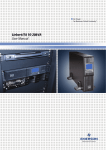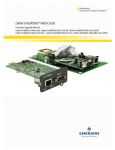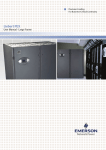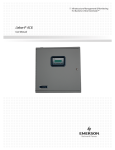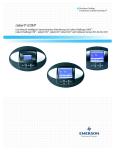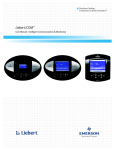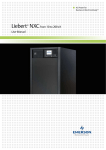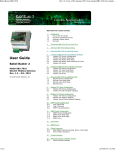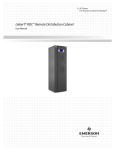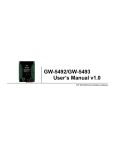Download Liebert® IntelliSlot Unity Card
Transcript
Liebert® IntelliSlot™ Unity™ Card User Manual—Web, SNMP, Modbus, BACnet, YDN23 Table of Content IMPORTANT SAFETY INSTRUCTIONS . . . . . . . . . . . . . . . . . . . . . . . . . . . . . . . . . . . . . . . . . . . . . . . 1 1.0 INTRODUCTION . . . . . . . . . . . . . . . . . . . . . . . . . . . . . . . . . . . . . . . . . . . . . . . . . . . . . . . . . . . 2 1.1 Protocols . . . . . . . . . . . . . . . . . . . . . . . . . . . . . . . . . . . . . . . . . . . . . . . . . . . . . . . . . . . . . . . . . . . . . . 2 1.2 Compatibility With Other Emerson Products and Communication Protocols . . . . . . . . . . . . . . . 3 1.3 Support for Liebert SN Sensors. . . . . . . . . . . . . . . . . . . . . . . . . . . . . . . . . . . . . . . . . . . . . . . . . . . . 4 2.0 INSTALLATION . . . . . . . . . . . . . . . . . . . . . . . . . . . . . . . . . . . . . . . . . . . . . . . . . . . . . . . . . . . . 5 2.1 Installing the Liebert IntelliSlot Unity Card . . . . . . . . . . . . . . . . . . . . . . . . . . . . . . . . . . . . . . . . . 5 2.1.1 Assigning the Card’s IP Address . . . . . . . . . . . . . . . . . . . . . . . . . . . . . . . . . . . . . . . . . . . 5 2.1.2 Connect an Ethernet Cable. . . . . . . . . . . . . . . . . . . . . . . . . . . . . . . . . . . . . . . . . . . . . . . . 6 2.1.3 Connect an RS-485 Serial Cable. . . . . . . . . . . . . . . . . . . . . . . . . . . . . . . . . . . . . . . . . . . . 7 2.2 Change User Names and Passwords Immediately . . . . . . . . . . . . . . . . . . . . . . . . . . . . . . . . . . . . 7 2.3 Configure the Card. . . . . . . . . . . . . . . . . . . . . . . . . . . . . . . . . . . . . . . . . . . . . . . . . . . . . . . . . . . . . . 8 2.4 Installing Multiple Liebert IntelliSlot Unity Cards in a System . . . . . . . . . . . . . . . . . . . . . . . . . 9 3.0 ENABLE COMMUNICATION PROTOCOLS . . . . . . . . . . . . . . . . . . . . . . . . . . . . . . . . . . . . . . . . 11 3.1 Enable Protocols . . . . . . . . . . . . . . . . . . . . . . . . . . . . . . . . . . . . . . . . . . . . . . . . . . . . . . . . . . . . . . . 11 3.1.1 Enable Modbus Protocol . . . . . . . . . . . . . . . . . . . . . . . . . . . . . . . . . . . . . . . . . . . . . . . . . 3.1.1.1 Configure Modbus TCP . . . . . . . . . . . . . . . . . . . . . . . . . . . . . . . . . . . . . . . . . . 3.1.1.2 Configure Modbus RTU . . . . . . . . . . . . . . . . . . . . . . . . . . . . . . . . . . . . . . . . . . 3.1.2 Enable BACnet Protocol . . . . . . . . . . . . . . . . . . . . . . . . . . . . . . . . . . . . . . . . . . . . . . . . . 3.1.2.1 Configure BACnet IP Protocol . . . . . . . . . . . . . . . . . . . . . . . . . . . . . . . . . . . . . 3.1.2.2 Configure BACnet MSTP Protocol. . . . . . . . . . . . . . . . . . . . . . . . . . . . . . . . . . 3.1.3 Enable SNMP . . . . . . . . . . . . . . . . . . . . . . . . . . . . . . . . . . . . . . . . . . . . . . . . . . . . . . . . . 3.1.3.1 Configure SNMP Settings . . . . . . . . . . . . . . . . . . . . . . . . . . . . . . . . . . . . . . . . 3.1.3.2 Configure SNMPv3 . . . . . . . . . . . . . . . . . . . . . . . . . . . . . . . . . . . . . . . . . . . . . . 3.1.3.3 Configure SNMPv1 Trap Settings . . . . . . . . . . . . . . . . . . . . . . . . . . . . . . . . . . 3.1.3.4 Configure SNMPv1/v2c Access Settings . . . . . . . . . . . . . . . . . . . . . . . . . . . . . 12 12 13 14 15 16 17 18 18 19 20 3.2 Download Protocol Mappings . . . . . . . . . . . . . . . . . . . . . . . . . . . . . . . . . . . . . . . . . . . . . . . . . . . . 21 4.0 LIEBERT INTELLISLOT UNITY CARD WEB PAGE LAYOUT . . . . . . . . . . . . . . . . . . . . . . . . . . . . 22 4.1 Web Page Sections . . . . . . . . . . . . . . . . . . . . . . . . . . . . . . . . . . . . . . . . . . . . . . . . . . . . . . . . . . . . . 22 4.3 Managed Device Tab Menus . . . . . . . . . . . . . . . . . . . . . . . . . . . . . . . . . . . . . . . . . . . . . . . . . . . . . 26 4.4 Communications Tab Menus . . . . . . . . . . . . . . . . . . . . . . . . . . . . . . . . . . . . . . . . . . . . . . . . . . . . . 27 4.5 Sensor Tab Menus—Shown Only if a Sensor is Connected . . . . . . . . . . . . . . . . . . . . . . . . . . . . . 28 4.5.1 Sensor Tab Summary Page. . . . . . . . . . . . . . . . . . . . . . . . . . . . . . . . . . . . . . . . . . . . . . . 29 4.5.2 Sensor Tab Summary Page-Details Pane . . . . . . . . . . . . . . . . . . . . . . . . . . . . . . . . . . . 29 4.6 Changing Sensor Order . . . . . . . . . . . . . . . . . . . . . . . . . . . . . . . . . . . . . . . . . . . . . . . . . . . . . . . . . 31 Liebert® CRV™ IntelliSlot™ Card User Manual i 5.0 EDIT THE LIEBERT INTELLISLOT UNITY CARD CONFIGURATION . . . . . . . . . . . . . . . . . . . . . . . 32 5.1 Web Page Communications Tab Folders . . . . . . . . . . . . . . . . . . . . . . . . . . . . . . . . . . . . . . . . . . . 33 5.1.1 Communications Tab-Active Events Folder . . . . . . . . . . . . . . . . . . . . . . . . . . . . . . . . . 33 5.2 Communications Tab-Downloads Folder . . . . . . . . . . . . . . . . . . . . . . . . . . . . . . . . . . . . . . . . . . . 33 5.3 Communications Tab-Configuration Folder . . . . . . . . . . . . . . . . . . . . . . . . . . . . . . . . . . . . . . . . . 33 5.3.1 Configuration Folder—System . . . . . . . . . . . . . . . . . . . . . . . . . . . . . . . . . . . . . . . . . . . . 34 5.3.1.1 Time Service Settings. . . . . . . . . . . . . . . . . . . . . . . . . . . . . . . . . . . . . . . . . . . . 34 5.3.2 Configuration Folder—User . . . . . . . . . . . . . . . . . . . . . . . . . . . . . . . . . . . . . . . . . . . . . . 35 5.3.3 Configuration Folder—Network . . . . . . . . . . . . . . . . . . . . . . . . . . . . . . . . . . . . . . . . . . . 35 5.3.3.1 IPv4/IPv6. . . . . . . . . . . . . . . . . . . . . . . . . . . . . . . . . . . . . . . . . . . . . . . . . . . . . . 36 5.3.3.2 Domain Name Server (DNS) Test . . . . . . . . . . . . . . . . . . . . . . . . . . . . . . . . . . 37 5.3.4 Configuration Folder—Web Server . . . . . . . . . . . . . . . . . . . . . . . . . . . . . . . . . . . . . . . . 37 5.3.5 Configuration Folder—LIFE™ . . . . . . . . . . . . . . . . . . . . . . . . . . . . . . . . . . . . . . . . . . . . . . . . . . . . . . . . 38 5.3.6 Configuration Folder—Emerson Protocol . . . . . . . . . . . . . . . . . . . . . . . . . . . . . . . . . . . 38 5.4 Configuration Folder—Messaging. . . . . . . . . . . . . . . . . . . . . . . . . . . . . . . . . . . . . . . . . . . . . . . . . 38 5.4.1 Email . . . . . . . . . . . . . . . . . . . . . . . . . . . . . . . . . . . . . . . . . . . . . . . . . . . . . . . . . . . . . . . . 5.4.2 Email Settings . . . . . . . . . . . . . . . . . . . . . . . . . . . . . . . . . . . . . . . . . . . . . . . . . . . . . . . . . 5.4.3 SMS . . . . . . . . . . . . . . . . . . . . . . . . . . . . . . . . . . . . . . . . . . . . . . . . . . . . . . . . . . . . . . . . . 5.4.4 Messaging Test . . . . . . . . . . . . . . . . . . . . . . . . . . . . . . . . . . . . . . . . . . . . . . . . . . . . . . . . 38 39 40 41 5.5 Communications Tab—Protocols. . . . . . . . . . . . . . . . . . . . . . . . . . . . . . . . . . . . . . . . . . . . . . . . . . 41 5.6 Protocols Folder—BACnet Folder . . . . . . . . . . . . . . . . . . . . . . . . . . . . . . . . . . . . . . . . . . . . . . . . . 42 5.6.1 Protocols Folder—BACnet IP Folder . . . . . . . . . . . . . . . . . . . . . . . . . . . . . . . . . . . . . . . 42 5.6.2 Protocols Folder—BACnet MSTP Folder . . . . . . . . . . . . . . . . . . . . . . . . . . . . . . . . . . . . 43 5.7 Protocols Folder—Modbus . . . . . . . . . . . . . . . . . . . . . . . . . . . . . . . . . . . . . . . . . . . . . . . . . . . . . . . 43 5.7.1 Modbus TCP. . . . . . . . . . . . . . . . . . . . . . . . . . . . . . . . . . . . . . . . . . . . . . . . . . . . . . . . . . . 43 5.7.2 Modbus RTU . . . . . . . . . . . . . . . . . . . . . . . . . . . . . . . . . . . . . . . . . . . . . . . . . . . . . . . . . . 44 5.8 Protocols Folder—SNMP Subfolder . . . . . . . . . . . . . . . . . . . . . . . . . . . . . . . . . . . . . . . . . . . . . . . 45 5.8.1 SNMPv3 User Settings . . . . . . . . . . . . . . . . . . . . . . . . . . . . . . . . . . . . . . . . . . . . . . . . . . 5.8.2 Edit the SNMPv3 Table . . . . . . . . . . . . . . . . . . . . . . . . . . . . . . . . . . . . . . . . . . . . . . . . . 5.8.3 SNMPv1 Trap Settings . . . . . . . . . . . . . . . . . . . . . . . . . . . . . . . . . . . . . . . . . . . . . . . . . . 5.8.4 SNMPv1/v2c Access. . . . . . . . . . . . . . . . . . . . . . . . . . . . . . . . . . . . . . . . . . . . . . . . . . . . . 46 47 48 49 5.9 Protocols Folder—YDN23 Protocol . . . . . . . . . . . . . . . . . . . . . . . . . . . . . . . . . . . . . . . . . . . . . . . . 50 5.10 Configuration—Communications Tab-Status Folder. . . . . . . . . . . . . . . . . . . . . . . . . . . . . . . . . 51 5.11 Configuration—Communications Tab-Support Folder . . . . . . . . . . . . . . . . . . . . . . . . . . . . . . . 51 5.11.1 Communications Tab-Support Folder—Active Networking . . . . . . . . . . . . . . . . . . . . 52 5.11.2 Communications Tab-Support Folder—Firmware Update. . . . . . . . . . . . . . . . . . . . . 53 ii Liebert® CRV™ IntelliSlot™ Card User Manual 6.0 FIRMWARE UPDATES . . . . . . . . . . . . . . . . . . . . . . . . . . . . . . . . . . . . . . . . . . . . . . . . . . . . . . 55 6.1 Updating the Liebert IntelliSlot Unity Card’s Firmware . . . . . . . . . . . . . . . . . . . . . . . . . . . . . . 55 6.2 Revert to Alternate Firmware . . . . . . . . . . . . . . . . . . . . . . . . . . . . . . . . . . . . . . . . . . . . . . . . . . . . 56 APPENDIX A - CONFIGURATION FOLDER—LIFE™ SUB FOLDER . . . . . . . . . . . . . . . . . . . . . . . . . 58 Liebert® CRV™ IntelliSlot™ Card User Manual iii List of Figures Figure 1-1 Liebert IntelliSlot Unity-DP card features . . . . . . . . . . . . . . . . . . . . . . . . . . . . . . . . . . . . . . . . . . . . . 2 Figure 2-1 Command prompt access . . . . . . . . . . . . . . . . . . . . . . . . . . . . . . . . . . . . . . . . . . . . . . . . . . . . . . . . . . . 7 Figure 2-2 Change administrator and general user names and passwords . . . . . . . . . . . . . . . . . . . . . . . . . . . . 8 Figure 2-3 Enabling the communication protocol—IPv4 or IPv6 . . . . . . . . . . . . . . . . . . . . . . . . . . . . . . . . . . . . 9 Figure 3-1 Enable protocols; enable commands . . . . . . . . . . . . . . . . . . . . . . . . . . . . . . . . . . . . . . . . . . . . . . . . . 12 Figure 3-2 Modbus TCP-Trusted IP List. . . . . . . . . . . . . . . . . . . . . . . . . . . . . . . . . . . . . . . . . . . . . . . . . . . . . . . 13 Figure 3-3 Modbus-RS-485 . . . . . . . . . . . . . . . . . . . . . . . . . . . . . . . . . . . . . . . . . . . . . . . . . . . . . . . . . . . . . . . . . 14 Figure 3-4 BACnet protocol settings . . . . . . . . . . . . . . . . . . . . . . . . . . . . . . . . . . . . . . . . . . . . . . . . . . . . . . . . . . 15 Figure 3-5 BACnet IP. . . . . . . . . . . . . . . . . . . . . . . . . . . . . . . . . . . . . . . . . . . . . . . . . . . . . . . . . . . . . . . . . . . . . . 16 Figure 3-6 BACnet MSTP . . . . . . . . . . . . . . . . . . . . . . . . . . . . . . . . . . . . . . . . . . . . . . . . . . . . . . . . . . . . . . . . . . 17 Figure 3-7 SNMP . . . . . . . . . . . . . . . . . . . . . . . . . . . . . . . . . . . . . . . . . . . . . . . . . . . . . . . . . . . . . . . . . . . . . . . . . 18 Figure 3-8 SNMPv3 user settings . . . . . . . . . . . . . . . . . . . . . . . . . . . . . . . . . . . . . . . . . . . . . . . . . . . . . . . . . . . . 19 Figure 3-9 SNMPv1 trap settings . . . . . . . . . . . . . . . . . . . . . . . . . . . . . . . . . . . . . . . . . . . . . . . . . . . . . . . . . . . . 20 Figure 3-10 SNMPv1/v2c Access settings . . . . . . . . . . . . . . . . . . . . . . . . . . . . . . . . . . . . . . . . . . . . . . . . . . . . . . 21 Figure 4-1 Web page sections, UPS example . . . . . . . . . . . . . . . . . . . . . . . . . . . . . . . . . . . . . . . . . . . . . . . . . . . 23 Figure 4-2 Web page sections, Thermal Management unit example . . . . . . . . . . . . . . . . . . . . . . . . . . . . . . . . 23 Figure 4-3 Managed Device Web page without sensors . . . . . . . . . . . . . . . . . . . . . . . . . . . . . . . . . . . . . . . . . . . 24 Figure 4-4 Help text on mouse-over . . . . . . . . . . . . . . . . . . . . . . . . . . . . . . . . . . . . . . . . . . . . . . . . . . . . . . . . . . 25 Figure 4-5 Managed Device Tab examples, Liebert GXT4™ and Liebert CRV™ . . . . . . . . . . . . . . . . . . . . . . . 26 Figure 4-6 Sensor Tab menu . . . . . . . . . . . . . . . . . . . . . . . . . . . . . . . . . . . . . . . . . . . . . . . . . . . . . . . . . . . . . . . . 28 Figure 4-7 Sensor Tab-Summary page layout . . . . . . . . . . . . . . . . . . . . . . . . . . . . . . . . . . . . . . . . . . . . . . . . . . 29 Figure 4-8 Sensor details—Door closure and temperature sensor examples . . . . . . . . . . . . . . . . . . . . . . . . . . 30 Figure 4-9 Changing sensor order . . . . . . . . . . . . . . . . . . . . . . . . . . . . . . . . . . . . . . . . . . . . . . . . . . . . . . . . . . . . 31 Figure 5-1 Editing configuration settings . . . . . . . . . . . . . . . . . . . . . . . . . . . . . . . . . . . . . . . . . . . . . . . . . . . . . . 32 Figure 5-2 Configuration folder, System subfolder . . . . . . . . . . . . . . . . . . . . . . . . . . . . . . . . . . . . . . . . . . . . . . 34 Figure 5-3 Configuration folder, System subfolder, Time Service. . . . . . . . . . . . . . . . . . . . . . . . . . . . . . . . . . . 34 Figure 5-4 IPv4/IPv6 settings . . . . . . . . . . . . . . . . . . . . . . . . . . . . . . . . . . . . . . . . . . . . . . . . . . . . . . . . . . . . . . . 36 Figure 5-5 Edit the SNMPv3 table . . . . . . . . . . . . . . . . . . . . . . . . . . . . . . . . . . . . . . . . . . . . . . . . . . . . . . . . . . . 47 Figure 6-1 Ethernet port . . . . . . . . . . . . . . . . . . . . . . . . . . . . . . . . . . . . . . . . . . . . . . . . . . . . . . . . . . . . . . . . . . . 55 Figure 6-2 Firmware update screen . . . . . . . . . . . . . . . . . . . . . . . . . . . . . . . . . . . . . . . . . . . . . . . . . . . . . . . . . . 56 Liebert® CRV™ IntelliSlot™ Card User Manual iii List of Tables Table 1-1: Compatibility with Liebert equipment . . . . . . . . . . . . . . . . . . . . . . . . . . . . . . . . . . . . . . . . . . . . . . . . 3 Table 1-2: Liebert IntelliSlot card communication protocols . . . . . . . . . . . . . . . . . . . . . . . . . . . . . . . . . . . . . . . . 3 Table 4-1: Help text and icons . . . . . . . . . . . . . . . . . . . . . . . . . . . . . . . . . . . . . . . . . . . . . . . . . . . . . . . . . . . . . . . 24 Table 4-2: Communications Tab menus . . . . . . . . . . . . . . . . . . . . . . . . . . . . . . . . . . . . . . . . . . . . . . . . . . . . . . . 27 Table 4-3: Sensor Tab folders. . . . . . . . . . . . . . . . . . . . . . . . . . . . . . . . . . . . . . . . . . . . . . . . . . . . . . . . . . . . . . . . 28 iv Liebert® IntelliSlot™ Unity™ Card User Manual Important Safety Instructions IMPORTANT SAFETY INSTRUCTIONS SAVE THESE INSTRUCTIONS ! WARNING Risk of improper installation. Can cause equipment damage, injury or death. Only a qualified service professional should install these products. Emerson recommends having an Emerson Network Power® Liebert Services representative perform the installation in large UPS’s. Contact Liebert Services at 1-800-LIEBERT (1-800-543-2378). ! WARNING Risk of electric shock. Can cause equipment damage, injury or death. Service and maintenance work must be performed only by properly trained and qualified personnel and in accordance with applicable regulations and manufacturers’ specifications. Opening or removing the covers to any equipment may expose personnel to lethal voltages within the unit even when it is apparently not operating and the input wiring is disconnected from the electrical source. Check the circuits with a voltmeter before beginning installation. Liebert® IntelliSlot™ Unity™ Card User Manual 1 Introduction 1.0 INTRODUCTION This Liebert IntelliSlot Unity platform delivers enhanced communication and control of AC Power, Power Distribution and Thermal Management products. The platform communicates withEmerson Network Power® software tools and services, including Trellis®, LIFE™ Services, Liebert SiteScan Web™ and Liebert Nform®. The platform includes the Liebert IntelliSlot Unity-DP™ and Liebert IntelliSlot Unity LIFE™ cards. Each card employs the Emerson Protocol to monitor and manage a wide range of operating parameters, alarms and notifications about power, distribution and cooling equipment. The cards also communicate with Building Management Systems and Network Management Systems. Liebert IntelliSlot Unity cards support monitoring of sensors to improve system reliability and efficiency. Figure 1-1 Liebert IntelliSlot Unity-DP card features RJ-45-Ethernet—HTTP; Modbus TCP; BACnet IP; SNMPv1, v2c, v3; Emerson Protocol BACnet MSTP Modbus RTU YDN23 Micro-USB AB (future release) IS-UNITY-DP Reset Button (Reboot or reset to factory defaults) Link 485 Activity Liebert Sensor Network 1.1 Protocols Each card supports the Emerson Protocol, Remote Service Delivery Protocol and HTTP Web by default. The Liebert IntelliSlot Unity-DP supports selecting two third-party protocols; the Liebert IntelliSlot Unity LIFE card supports the default protocols only (Emerson Protocol, Remote Service Delivery Protocol and HTTP Web). Available protocols are • BACnet IP—BACnet over Internet Protocol • BACnet MSTP—BACnet Master-Slave/Token-Passing (MSTP) communications protocol over a RS-485 serial network (also known as BACnet MSTP RS-485) • Modbus RTU—Modbus Remote Terminal Unit (RTU) communication protocol over a RS-485 serial network (also known as Modbus RTU RS-485) • Modbus TCP—Modbus Transmission Control Protocol over Internet Protocol (also known as Modbus TCP/IP) • SNMP • YDN23 - YD-T-1363 specification protocol (also known as YD/T 1363) 2 Liebert® IntelliSlot™ Unity™ Card User Manual Introduction 1.2 Compatibility With Other Emerson Products and Communication Protocols The Liebert IntelliSlot Unity platform includes: Table 1-1 Compatibility with Liebert equipment Liebert IntelliSlot Card Compatible with: Liebert IS-UNITY-DP Liebert IS-UNITY-LIFE Liebert APM™, Liebert APS™, Liebert Challenger 3000™, Liebert CRV™, Liebert CW™, Liebert DCP™, Liebert Deluxe System/3™, Liebert DS™, Liebert DSE™, Liebert eXL™, Liebert eXM™, Liebert GXT3™, Liebert GXT4™, Liebert HPC™ Liebert HPC-S/M/R/W/Generic™, Liebert HPM™, Liebert NX™ 225-600 kVA, Liebert NXC™, Liebert NXL™ *, Liebert NXR™, Liebert PCW™/PDX™, Liebert PeX™ *, Liebert XDC™, Liebert XDP™, Liebert XDP-Cray™ The Liebert IntelliSlot Unity-DP platform supports the following protocols: Table 1-2 Liebert IntelliSlot card communication protocols Liebert IntelliSlot Card (Part #) Communication Protocols Available Remote Service HTTP Emerson Delivery SNMP HTTPS Protocol Protocol Email SMS v1,v2c, v3 BACnet IP BACnet MSTP Modbus TCP Modbus RTU YDN23 * Liebert IS-UNITY-DP (IS-UNITY-DP) Liebert IS-UNITY-LIFE (IS-UNITY-LIFE) — — — — — — * YDN23 applicable only to Liebert PeX and Liebert NXL. The Liebert IntelliSlot Unity platform supports both 10Mbit and 100Mbit communication speeds and either half or full duplex. Sensor Support The Liebert IntelliSlot Unity platform supports these sensors: Liebert SN-2D, Liebert SN-3C, Liebert SN-L, Liebert SN-T, Liebert SN-TH, Liebert SN-Z01, Liebert SN-Z02 and Liebert SN-Z03. Password Protection Control and configuration capabilities are protected by an administrator’s username and password combination. Optionally, status information can be password-protected. The default user name for the administrator is Liebert and the default password is also Liebert. The user name and password can be changed with the Web interface. See 2.2 - Change User Names and Passwords Immediately for details. SNMP Support The Liebert IntelliSlot Unity card enables SNMP management of Liebert equipment. To integrate the card into a SNMP implementation, import or compile the Liebert Global Products MIB on the network management station (NMS). The Liebert Global Products MIB is available at Liebert’s Web site (www.liebert.com); it supports both Windows® (192436P1) and Unix (192435P1) file formats. Web Support The Liebert IntelliSlot Unity card delivers Web management and control to Liebert equipment over HTTP and HTTPS. All authorized users on your network will be able to view status information. Modbus TCP and Modbus RTU Support The Liebert IntelliSlot Unity card supports Modbus TCP and Modbus RTU for the full range of information available from the managed device. The Modbus protocol mapping document, SL-28170, is available at Liebert’s Web site: www.liebert.com Liebert® IntelliSlot™ Unity™ Card User Manual 3 Introduction BACnet IP and BACnet MSTP Support The Liebert IntelliSlot Unity card supports BACnet IP and BACnet MSTP for the full range of information available from the managed device. The BACnet protocol mapping document, SL-28170, is available at Liebert’s Web site: (www.liebert.com). This document includes the BACnet Protocol Implementation Conformance Statement (PICS) document as a guide to implementing the BACnet protocol. YDN23 Support The Liebert IntelliSlot Unity card supports YD/T-1363 specification for the full range of information available from managed Liebert NXL™ or Liebert PeX™ units. Trellis™ Support The Liebert IntelliSlot Unity-DP card communicates a rich set of Emerson Protocol information to the Trellis DCIM platform. Trellis can manage and control Liebert equipment using SNMP, Modbus or the Emerson Protocol. This allows monitoring all Liebert equipment using Liebert IntelliSlot Web, Liebert IntelliSlot 485, Liebert IntelliSlot IPBML, Liebert IntelliSlot Web ADPT or Liebert IntelliSlot Unity platform communication interfaces. Liebert Nform® Support Utilizing the Emerson Protocol or SNMP and Web technologies built into each Liebert IntelliSlot Unity card, Liebert Nform will centrally manage alarm notifications to provide an easy interface to access critical equipment information. A downloadable version is available online at: nform.liebert.com Liebert MultiLink® Support The Liebert IntelliSlot Unity card integrates with Liebert’s MultiLink software to provide unattended, graceful operating system shutdown of PCs, servers and workstations. The card can be monitored by Liebert MultiLink over the network, eliminating the need for serial cables. For more information on Liebert MultiLink and a downloadable version of Liebert MultiLink software, visit multilink.liebert.com 1.3 Support for Liebert SN Sensors The Liebert IntelliSlot Unity card supports connection and monitoring up to 10 Liebert SN modular and integrated sensors. Available sensor types include temperature, humidity, door closure, contact closure and leak detection. Sensor Tab menus permit configuring sensors and putting them in order for easier checking of high-priority conditions. 4 Liebert® IntelliSlot™ Unity™ Card User Manual Installation 2.0 INSTALLATION ! WARNING Risk of improper installation. Can cause equipment damage, injury or death. Only a qualified service professional should install these products. Emerson recommends having an Emerson Network Power® Liebert Services representative perform the installation in large UPS’s. Contact Liebert Services at 1-800-LIEBERT (1-800-543-2378). NOTICE Risk of duplicate node ID’s if two or more Liebert IntelliSlot cards are installed. Can cause network conflicts. An internal networking conflict may occur within a device when multiple communication cards with duplicate Node IDs are installed in the device. Each Liebert IntelliSlot card must have a unique node ID. This will not be a problem if only one card is installed on your system. Duplicate node ID’s are easily averted with the procedure detailed in 2.4 - Installing Multiple Liebert IntelliSlot Unity Cards in a System. 2.1 Installing the Liebert IntelliSlot Unity Card The Liebert IntelliSlot Unity card may be installed at the factory or field-installed. To perform a field-installation: 1. Find the Liebert IntelliSlot bay on your Liebert equipment—It may have a plastic cover. 2. Insert the card into the Liebert IntelliSlot bay. NOTE The card will only fit one way in the Liebert IntelliSlot bay because the circuit board is not centered on the faceplate. The slot in the Liebert IntelliSlot bay also is not centered. 3. Secure the card with the screws supplied with the cover plate. 4. Connect an Ethernet cable to the card’s Ethernet RJ-45 port for IP communication interfaces. 5. Connect a serial cable to the card’s 485 RJ-45 port for RS-485 communication interfaces (see 2.1.3 - Connect an RS-485 Serial Cable. 2.1.1 Assigning the Card’s IP Address DHCP The Liebert IntelliSlot Unity card is factory-configured for DHCP. If a Static or BootP network configuration is required, change the Boot Mode as described in Static IP on page 6. Connect an RJ-45 cable to the card and it will receive an IP address from the DHCP server. Contact the DHCP administrator to obtain the IP address using the Liebert IntelliSlot Unity card’s MAC address. The MAC address is printed on the card’s faceplate. Liebert® IntelliSlot™ Unity™ Card User Manual 5 Installation If the DHCP administrator is not available or there is no way of determining the IP address assigned by the DHCP server, use a computer with a direct Ethernet connection to the Liebert IntelliSlot Unity card, and the Autoconfiguration IPv4 Address convention described in 2.1.2 - Connect an Ethernet Cable to access the card’s Web page and configure the card. To see the card’s last DHCP-assigned IP address, click on the Communications Tab, then on the left side menu select Support > Active Networking. The table of information will show the last IP address assigned by the DHCP server. The card may retain that IP address when it reconnects to the DHCP network because most DHCP systems reuse the same IP address for the same device. IS-UNITY-DP Link Activity 485 Communications Tab Last DHCP Address Support>Active Networking Static IP To assign a static IP address, use the Ethernet connection to configure the card. Proceed to 2.1.2 Connect an Ethernet Cable and 2.2 - Change User Names and Passwords Immediately. 2.1.2 Connect an Ethernet Cable 1. Connect a computer running a Microsoft Windows operating system (Microsoft Windows® XP with SP2 [64-bit] or SP3 [32-bit] or later) to the card by plugging a network cable into the RJ-45 port on the computer and the Liebert IntelliSlot Unity card. 2. Autoconfiguration, which is normally enabled on computers running Microsoft Windows operating systems, will automatically negotiate the communication settings. This takes about one minute. NOTE If the computer does not automatically connect, verify that autoconfiguration is enabled by: Open the Command Prompt window from the computer’s Start menu. Enter ipconfig/all to verify that Autoconfiguration is enabled on the computer and that an Autoconfiguration IPv4 Address has been assigned: Enabled = Yes (see Figure 2-1). An Autoconfiguration IPv4 Address begins with 169.254.) 6 Liebert® IntelliSlot™ Unity™ Card User Manual Installation 3. If the Ethernet adapter being used to attach to the card does not show an Autoconfiguration IPv4 Address, open a new Command Prompt and type ipconfig/renew and press Enter. This forces the computer to acquire an Autoconfiguration IPv4 Address. 4. When the computer has an Autoconfiguration IPv4 Address, open a browser window on the computer and type 169.254.24.7 (the card’s default Autoconfiguration IPv4 Address) in the URL address field. The card’s Web page will appear. Figure 2-1 Command prompt access 2.1.3 Connect an RS-485 Serial Cable For Building Management Systems using serial network connections, an RS-485 serial cable connection will be used. Liebert IntelliSlot Unity cards come with an Adapter RJ-45-2POS Terminal Block. The adapter has two screw terminals to attach the ends of a RS-485 cable for communicating to a building management system. 1. Find the serial cable from the building management system. If it already has an RJ-45 connector on the end, determine whether it uses the same pinout as the Liebert IntelliSlot Unity card’s connector. If the pinout is the same as the Liebert IntelliSlot Unity card connector’s pinout, skip to Step 7. 2. Strip the ends of the positive (typically red) and negative (typically black) leads on the RS-485 cable so that enough bare wire is exposed for connection, about 1/4" (6mm). 485- + Screws NOTE No bare wire should be exposed when the connection is completed. 3. Position the adapter so the side with the positive and negative marks is face up. The small markings are on the same side as the screw heads, as shown at right. Wires 4. Loosen the screw to the positive terminal and insert the red wire far enough to insert the bare wires into the terminal block under the screw, then tighten the screw. 5. Be careful not to break the wires. 6. Repeat Step 3 with the negative terminal and the black wire. 7. Plug the cable into the 485 RJ-45 port on the Liebert IntelliSlot Unity card. 2.2 Change User Names and Passwords Immediately Emerson recommends changing the administrative user name and password immediately to safeguard protected configuration and control areas of the Liebert IntelliSlot Unity card. The user name and password are set at the factory; each is Liebert (case-sensitive). All printable characters are valid except \ : ’ < > ~ ? " # Liebert® IntelliSlot™ Unity™ Card User Manual 7 Installation A general user name and password are also set at the factory: User and User (case-sensitive). This may be left at the factory default or changed. The general user has access only to non-protected configuration and control areas of the Liebert IntelliSlot Unity card. To change the default user names: 1. Select the Communications Tab > Configuration > User. 2. Click the Edit button and enter the factory-set administrator user name (Liebert) and password (Liebert). 3. Click OK. 4. Enter a new administrator user name and password. 5. Re-enter the administrator password to confirm it. 6. Optional General User Name Change 7. Enter a new general user name and password. 8. Re-enter the general user’s password to confirm it. 9. Click the Save button to confirm the changes or click Cancel to discard them. NOTE Record the new user names and passwords and save them in a secure place where they can be found if forgotten. A lost password cannot be retrieved. If the password is lost, the card must be reset to factory defaults and reconfigured. Figure 2-2 Change administrator and general user names and passwords Administrator User Name and Password General User Name and Password 2.3 Configure the Card The Liebert IntelliSlot Unity card requires minor configuration, such as choosing the IP/Web communication interface, serial RS-485 communication interface, or both. The default for IP/Web communication is IPv4, but this can be changed to IPv6 for greater security; contact your network administrator to determine whether it is compatible with your network. To choose the communication interface refer to Figure 2-3: 1. Select Communications Tab > Configuration > Network. 8 Liebert® IntelliSlot™ Unity™ Card User Manual Installation 2. Enable the protocol, either IPv4 or IPv6, that will be used to communicate with the Liebert IntelliSlot Unity card and with the Liebert equipment. a. Click on either IPv4 or IPv6. b. Click the Edit button. c. When prompted with a login display, enter the user name and password (the defaults are Liebert and Liebert). d. Put a check mark (?) in the enabled box. e. Insert the desired or assigned IP address along with the rest of the required networking information; contact your system administrator if necessary. 3. Click on Save to confirm the changes or click on Cancel to discard them. The changes will take effect after the card is restarted. Figure 2-3 Enabling the communication protocol—IPv4 or IPv6 Edit Button Edit Dialog Box Save and Cancel Buttons IPv4 Settings Shown Enter the Administrator Name and Password; defaults are Liebert and Liebert These should have been changed to enhance security; see 2.2 - Change User Names and Passwords Immediately 2.4 Installing Multiple Liebert IntelliSlot Unity Cards in a System More than one Liebert IntelliSlot card may be installed in a system, but circular routes and duplicate node ID’s must be avoided during installation. The instructions below apply if the second card to be installed is a Liebert IntelliSlot Unity card. If the second card is not a Liebert IntelliSlot Unity card, follow instructions in the user manual for that card. Before beginning installation of a second Liebert IntelliSlot card, verify that the first card functions properly. If the first card is a Liebert IntelliSlot card, but not a Liebert IntelliSlot Unity card, and if both cards connect to the same Ethernet network, then you should disable the router function on the first card. This will avoid circular routes. Follow instructions in the user manual for the first card. If the first and second cards are both Liebert IntelliSlot Unity cards, steps must be taken to avoid duplicate Emerson Protocol MSTP node ID’s. By default, the two cards would use the same node ID, and one or both cards would report a duplicate node error and fail to communicate with the system. The default node ID for a Liebert IntelliSlot Unity card is 0, so the second card should use 1 or 2 preferably, or 127 if necessary. Contact your system administrator about the proper node ID for the second card, then perform the steps below. 1. Open a Web browser and navigate to the second Liebert IntelliSlot Unity card. 2. Click on Communications Tab > Configuration > Emerson Protocol > MSTP. 3. Click on Edit and enter a password and username, if required. 4. Enter the new node ID. Liebert® IntelliSlot™ Unity™ Card User Manual 9 Installation 5. Click Save to confirm the changes or click Cancel to discard them. 6. Restart the card as follows. a. Select the Communications Tab > Support. b. Click on Enable. c. Click on Restart. 10 Liebert® IntelliSlot™ Unity™ Card User Manual Enable Communication Protocols 3.0 ENABLE COMMUNICATION PROTOCOLS The Liebert IntelliSlot Unity card will communicate with equipment and third-party systems over these protocols: • BACnet IP • BACnet MSTP • Modbus TCP • Modbus RTU • SNMP • YDN23 NOTE No more than two protocols may be enabled on one card. • Only one version of BACnet may be selected, either BACnet IP or BACnet MSTP • Only one version of Modbus may be selected, either Modbus TCP or Modbus RTU • Only one of the protocols can use the 485 port; choosing two 485 protocols will cause conflicts. NOTE Some Building Management Systems can be configured to send continuous updates for device setpoints, usually setting the same value. The BMS should be configured to send, on a sustained average, no more than two writes per second to the device. This will allow the device to catch up after a burst of updates when required while allowing other communication with the device to proceed. 3.1 Enable Protocols Protocols may be enabled after a card has been installed and configured. After a protocol is enabled, it must be configured, which requires opening that protocol’s folder (Communications Tab>Protocols> (desired protocol). To enable two communication protocols: 1. Select Communications Tab > Protocols. 2. Click on Edit and enter the administrator user name and password. 3. Put a check mark (?) in the desired protocols—Only two may be enabled; only one of the two can use the 485 port. 4. Click Save to confirm the changes or click on Cancel to discard them. 5. Configure the protocols selected. For details, refer to 5.0 - Edit the Liebert IntelliSlot Unity Card Configuration. Liebert® IntelliSlot™ Unity™ Card User Manual 11 Enable Communication Protocols 6. Restart the card (refer to 5.11 - Configuration—Communications Tab-Support Folder). a. Select Communications Tab > Support. b. Enable the commands. c. Click on Restart. Figure 3-1 Enable protocols; enable commands Enable Two Protocols Enable Commands (Communications Tab>Support Folder) 3.1.1 Enable Modbus Protocol Protocols may be enabled after a card has been installed and configured. To enable Modbus protocol: 1. Select Communications Tab > Protocols > Modbus. 2. Click on Edit and enter a User name and password. 3. Select the access level (Read Only or Read/Write). 4. Select the Modbus interface, (Modbus TCP or Modbus RTU). 5. Click Save to confirm the changes or click on Cancel to discard the changes. 6. Configure the Modbus interface chosen; refer to Configure Modbus TCP or Configure Modbus RTU. For additional details, see 5.7 - Protocols Folder—Modbus. 3.1.1.1 Configure Modbus TCP 1. Select the Communications Tab > Protocols > Modbus TCP. 2. Click on Edit and enter a User name and password if required. 3. Set the Limit Network Access Type by choosing from the drop-down list (Open/Same Subnet/Trusted IP List). Refer to 5.7 - Protocols Folder—Modbus for additional details. 4. Enter the port to be used by the Modbus Server to listen for and respond to Modbus protocol requests based on limit Network Access Type setting. 5. Enter the Maximum Client Connection Count. 12 Liebert® IntelliSlot™ Unity™ Card User Manual Enable Communication Protocols 6. Click Save to confirm the changes or click on Cancel to discard them. 7. Restart the card to confirm the changes. a. Select Communications Tab > Support. b. Enable the commands. c. Click on Restart. Figure 3-2 Modbus TCP-Trusted IP List ... brings up a screen where this information may be entered. Clicking on one of the five Trusted IP List folders ... 3.1.1.2 Configure Modbus RTU 1. Select the Communications Tab > Protocols > Modbus RTU. 2. Click on Edit and enter a user name and password if required. 3. Set the Node ID and the Baud Rate. 4. The Node ID defaults to 1, but must have a value from 1 to 255 that is unique among devices connected through the RS-485 interface. 5. The default baud rate is 9600; 19200 and 38400 also available. 6. Contact your system administrator if you are uncertain about the settings. Liebert® IntelliSlot™ Unity™ Card User Manual 13 Enable Communication Protocols 7. Click Save to confirm the changes or click on Cancel to discard them. 8. Restart the card to confirm the changes. a. Select Communications Tab > Support. b. Enable the commands. c. Click on Restart. Figure 3-3 Modbus-RS-485 Node ID must be unique on the RS-485 bus this card is connected to. 3.1.2 Enable BACnet Protocol Contact your system administrator or building management system administrator if you are uncertain about the settings. 1. Select Communications Tab > Protocols > BACnet. 2. Click on Edit and enter a user name and password if required. 3. Enter the Managed Device Write Access level (Read Only or Read/Write). This determines a user’s ability to change settings in the Liebert IntelliSlot Unity card. 4. Choose the BACnet interface, either BACnet IP or BACnet MSTP 5. Set the Device Object Instance Number. 6. Set the Device Object Name. 7. Set the APDU Timeout. 8. Set the APDU Retries. 14 Liebert® IntelliSlot™ Unity™ Card User Manual Enable Communication Protocols 9. Click Save to confirm the changes or click on Cancel to discard them. 10. Configure the BACnet interface chosen; refer to Configure BACnet IP Protocol or Configure BACnet MSTP Protocol. For additional details, see 5.6 - Protocols Folder—BACnet Folder. Figure 3-4 BACnet protocol settings 3.1.2.1 Configure BACnet IP Protocol Contact your system administrator if you are uncertain about the settings. 1. Select Communications Tab > Protocols > BACnet IP. 2. Click on Edit and enter a User name and password if required. 3. Set the BACnetIP/Port Number 4. If the Liebert IntelliSlot Unity card is on a different subnet, a possibility when the monitored units are part of a Liebert SiteScan network or other third-party monitoring service: a. Choose whether to enable Register as Foreign Device. b. Enter the IP address of the BBMD (BACnet Broadcast Management Device). c. Enter a time in seconds for Foreign Device Time-to-Live. 5. Click Save to confirm the changes or click on Cancel to discard them. Liebert® IntelliSlot™ Unity™ Card User Manual 15 Enable Communication Protocols 6. Restart the card to activate the changes. a. Select the Communications Tab > Support. b. Enable the commands. c. Click on Restart. Figure 3-5 BACnet IP 3.1.2.2 Configure BACnet MSTP Protocol Contact your system administrator if you are uncertain about the settings. 1. Select Communications Tab > Protocols > BACnet MSTP. 2. Click on Edit and enter a user name and password if required. 3. Set the BACnet MSTP Node ID. The ID default is 1. 4. Set the BACnet MSTP Data Rate. 5. Set the BACnet MSTP Max Master Address. 6. Set the BACnet MSTP Max Info Frames. The default is 8. 16 Liebert® IntelliSlot™ Unity™ Card User Manual Enable Communication Protocols 7. Click Save to confirm the changes or click on Cancel to discard them. 8. Restart the card to activate the changes. a. Select Communications Tab > Support. b. Enable the commands. c. Click on Restart. Figure 3-6 BACnet MSTP 3.1.3 Enable SNMP SNMPv1/v2c and SNMPv3 are enabled by default. The protocols may be configured or their default values may be accepted. Authentication Traps are not enabled by default. The default Heartbeat Trap interval is 24 hours; this can be disabled or the interval may be changed. 1. Select the Communications Tab > Protocols > SNMP. 2. Click on Edit and enter a User name and password if required. 3. To enable Authentication Traps, put a check mark (?) in the box. 4. To change the Heartbeat Trap Interval, choose a time from the drop-down list or choose Disabled to prevent any heartbeat traps from being sent. 5. The interval times offered are 5 minutes, 30 minutes, or 1, 4, 8, 12 or 24 hours. 6. Choose whether to disable the traps or to set the interval to one of the periods on the menu. Liebert® IntelliSlot™ Unity™ Card User Manual 17 Enable Communication Protocols 7. Click Save to confirm the changes or click on Cancel to discard them. 8. Restart the card to activate the changes. a. Select the Communications Tab > Support. b. Enable the commands. c. Click on Restart. Figure 3-7 SNMP 3.1.3.1 Configure SNMP Settings SNMPv3 Users or SNMPv1/v2c Trap and Access settings must be made before SNMP access or notifications can occur. The Liebert IntelliSlot Unity card permits up to 20 SNMPv3 Users, up to 20 SNMPv1 Trap targets, and up to 20 SNMPv1/v2c Access addresses. The required changes vary according to the type of SNMP protocol used. For SNMPv1, trap settings must be made. SNMPv2c must have Access settings made. SMPv3 users must have settings configured. SNMPv1 trap settings are separate from the access settings for SNMPv1/v2c. 3.1.3.2 Configure SNMPv3 The settings must be made for each user who will receive notifications. 1. Select Communications Tab > Protocols > SNMP > SNMPv3 Users Setting (20) > SNMPv3 Users Setting (1). 2. Click on Edit and enter a User name and password if required. 3. Enter the information and set the permissions appropriate to the user. Refer to Figure 3-8 for the information required. 4. Click Save to confirm the changes or click on Cancel to discard them. 18 Liebert® IntelliSlot™ Unity™ Card User Manual Enable Communication Protocols 5. Repeat Steps 1 through 4 for any additional users. 6. Restart the card to activate the changes. a. Select the Communications Tab > Support. b. Enable the commands. c. Click on Restart. Figure 3-8 SNMPv3 user settings Settings are required for each user 3.1.3.3 Configure SNMPv1 Trap Settings 1. Select Communications Tab > Protocols > SNMP > SNMPv1 Trap (20). 2. Click on Edit and enter a User name and password if required. 3. Enter the information and set the permissions appropriate to the user. Refer to Figure 3-9 for the information required. 4. Click Save to confirm the changes or click on Cancel to discard them. Liebert® IntelliSlot™ Unity™ Card User Manual 19 Enable Communication Protocols 5. Repeat Steps 1 through 4 for any additional users. 6. Restart the card to confirm the changes. a. Select the Communications Tab > Support. b. Enable the commands. c. Click on Restart. Figure 3-9 SNMPv1 trap settings Settings required for each address that will receive SNMP notifications. 3.1.3.4 Configure SNMPv1/v2c Access Settings 1. Select Communications Tab > Protocols > SNMP > SNMPv1/v2c Access (20) > SNMPv1/v2c Access (1). 2. Click on Edit and enter a User name and password if required. 3. Enter the information and set the permissions appropriate to the user. Refer to Figure 3-9 for the information required. 20 Liebert® IntelliSlot™ Unity™ Card User Manual Enable Communication Protocols 4. Click Save to confirm the changes or click on Cancel to discard them. 5. Restart the card to confirm the changes—The card must be restarted before another user’s settings may be changed. a. Select the Communications Tab > Support. b. Enable the commands. c. Click on Restart. Figure 3-10 SNMPv1/v2c Access settings Selecting the SNMPv1/v2c Access folder will bring up the settings that may be changed. 3.2 Download Protocol Mappings The Liebert IntelliSlot Unity Card’s permits downloading files listing information available from a managed device for each enabled protocol. The listings identify the data available from the device and how that data will be represented, or mapped, into a particular protocol. To download a data mapping list, click on the Managed Device tab, then Summary > Downloads. The Data Mapping Files heading will show mapping files for each enabled protocol: • BACnetDataMap.txt for BACnet IP and BACnet MSTP • ModbusDataMap.txt for Modbus TCP and Modbus RTU • SNMP_Events.txt, SNMP_Parameters.txt, SNMP_upsMibEvents.txt, and SNMP_upsParams.txt for SNMP v1/v2c/v3 • Ydn23DataMap.txt for YDN23 More information about BACnet and Modbus protocol mapping is available in the Liebert IntelliSlot Modbus RTU, Modbus TCP, BACnet MSTP and BACnet IP Reference Guide (SL-28170) at Liebert’s Web site: www.liebert.com The SNMP MIB files are also available for download from the Web site. Liebert® IntelliSlot™ Unity™ Card User Manual 21 Liebert IntelliSlot Unity Card Web Page Layout 4.0 LIEBERT INTELLISLOT UNITY CARD WEB PAGE LAYOUT Default settings in the Liebert IntelliSlot Unity card permit using it immediately after installation to monitor the equipment the card is installed in. The Web interface permits customizing the information to ease monitoring the equipment and troubleshooting problems. Users can name the equipment, enter a location, set up e-mail and text alerts and change equipment settings. NOTE The Edit button will be grayed-out if the settings on a menu cannot be changed. 4.1 Web Page Sections Each Web page displayed by the Liebert IntelliSlot Unity card has these main areas (see Figure 4-1): • Identification • Status • Tab Menus • Detail Identification Displays the System Name, System Location and System Description Status Displays the status of the monitored equipment, the Liebert IntelliSlot Unity card and any Liebert SN sensors connected to the card. Tab Menus The Liebert IntelliSlot Unity card has two tabs by default: the Managed Device Tab, which will display the name of the monitored equipment, and the Communications Tab. A third tab, the Sensor Tab, appears if Liebert SN sensors have been installed. The tab selected determines the menu shown. • Managed Device Tab—Information pertaining to the equipment being monitored and controlled. Refer to 4.3 - Managed Device Tab Menus for details. The tab label refers to the type of Liebert unit the card is installed in. For example, the Managed Device Tab for a card installed in a Liebert GXT4-1000-RT120 UPS will be labeled GXT4-1000-RT120 (see Figure 4-1 for this example). Figure 4-2 shows a Web page for a Liebert IntelliSlot Unity card installed in a Liebert CRV. • Communications Tab—Information about the Liebert IntelliSlot Unity card, such as the overall event status of the equipment and communication interface, logs of third-party information, communication settings, third-party protocol settings and system status. Refer to 4.4 - Communications Tab Menus for details. • Sensor Tab—Information about Liebert SN sensors, if any are installed, including status or data from each sensor and sensor configuration settings. When sensors are connected to the card, this tab appears between the Managed Device Tab and the Communications Tab. The tab is not shown when no sensors are connected to the card (see Figure 4-3). Refer to 4.5 - Sensor Tab Menus— Shown Only if a Sensor is Connected for details. 22 Liebert® IntelliSlot™ Unity™ Card User Manual Liebert IntelliSlot Unity Card Web Page Layout Detail Displays detailed information about the device based on the menu selection made in the Tab Menu area. Edits to the device and its configuration are made in this section. Figure 4-1 Web page sections, UPS example Managed Device Tab Card in a Liebert GXT4™ Sensor Tab Communications Tab Information on the Opening Screen depends on type of unit being monitored. Identification Status (Status of equipment, sensors, if any are installed, and communications) Tab Menu (changes according to monitored equipment) Figure 4-2 Web page sections, Thermal Management unit example Managed Device Tab Card in a Liebert CRV™ Sensor Tab Communications Tab Information on Opening Screen depends on type of unit being monitored Identification Status Tab Menu (changes according to monitored equipment) Liebert® IntelliSlot™ Unity™ Card User Manual 23 Liebert IntelliSlot Unity Card Web Page Layout Figure 4-3 Managed Device Web page without sensors Sensor Tab not displayed Sensor Status not displayed 4.2 Help Text Each Web page shown by the Liebert IntelliSlot Unity-DP card has informational text that is revealed by hovering a mouse pointer over the icon to the left of the Status, Events or Settings row, as shown below. The Web page may display any of six icons beside the Status, Events or Setting entry: Table 4-1 Icon Help text and icons Description a check mark (?) on a green button (Event Normal) i an i on a blue button (Event Information) x an x on a red button (Event Alarm) ! an exclamation point (!) on a yellow shield (Event Warning) ! an exclamation point (!) on a red button (Event Critical) i an i in a word balloon (Tool Tip). 24 Liebert® IntelliSlot™ Unity™ Card User Manual Liebert IntelliSlot Unity Card Web Page Layout Figure 4-4 Help text on mouse-over Hovering a mouse pointer over the icon reveals information about that entry. Help text about the System Input Nominal Frequency entry on the Managed Device Tab, Input Menu. Liebert® IntelliSlot™ Unity™ Card User Manual 25 Liebert IntelliSlot Unity Card Web Page Layout 4.3 Managed Device Tab Menus Menus on the Managed Device Tab list only data that is relevant to the equipment being monitored. For example, menus shown by a Liebert IntelliSlot Unity card installed in a UPS differ from menus shown by a card installed in Thermal Management equipment. Information on those menus will also differ depending on the equipment the card is installed in. Figure 4-5 Managed Device Tab examples, Liebert GXT4™ and Liebert CRV™ The Managed Device Tab will display Status or Events for the applicable equipment only. Power information is shown in this Managed Device Tab for a UPS. The Managed Device Tab will display Status, Events or Settings for the applicable equipment only. Environmental information is shown in this Managed Device Tab for Thermal Management equipment. 26 Liebert® IntelliSlot™ Unity™ Card User Manual Liebert IntelliSlot Unity Card Web Page Layout 4.4 Communications Tab Menus The Communications Tab shows the overall event status of the equipment and communication interface. It contains logs of third party information, communications settings, third party protocol settings and system status information as detailed below. Table 4-2 Communications Tab menus Communications Tab Menus Active Events Downloads Agent (or Unity Card) Logs Event Logs Data Logs Other files Configuration System User Network Web Server LIFE Emerson Protocol Messaging Protocols Modbus BACnet SNMP YDN23 Status System Status System Restart Required LIFE™ device identity changed-LIFE™ needs to be reconfigured RS-485 Port Conflict Duplicate Emerson Protocol MSTP Node ID Duplicate BACnet MSTP Node ID Support Agent time and Date Agent Model Agent App Firmware Version Agent App Firmware Label Agent Boot Firmware Version Agent Boot Firmware Label Agent Serial Number Agent Manufacture Date Agent Hardware Version GDD Version FDM Version Product Sequence ID Restart Card Reset Card to Factory Defaults (see Note below) Generate and download diagnostic file Firmware Update Active Networking Description Displays the current event activity See Details: page 33 Downloading files to text-accessible, commadelimited or tab-delimited files ease troubleshooting. page 33 Displays information about the system setup, access, network connections, Emerson Protocol settings and whether e-mail and SMS messaging are enabled page 33 Lists information and settings related to available third-party protocols employed to monitor equipment. page 41 Shows the overall condition of the system and whether a restart is needed to activate configuration changes; restart is performed only from the Support Folder page 51 Shows information needed for maintenance or troubleshooting and shortcuts to reboot the card, reset the Liebert IntelliSlot Unity card to its factory defaults and to update the card’s firmware. page 51 (Firmware Update also on page 55) NOTE The card may be reset to factory defaults manually by briefly pressing the reset button five times within 10 seconds. Do not hold the reset button too long: Pressing the reset button and holding it for 5 seconds will restart the card without resetting it to factory defaults. To perform either function, insert a straight, non-conductive tool into the small hole on the front of the card (see Figure 1-1 for the Reset Button’s location). Liebert® IntelliSlot™ Unity™ Card User Manual 27 Liebert IntelliSlot Unity Card Web Page Layout 4.5 Sensor Tab Menus—Shown Only if a Sensor is Connected When Liebert SN sensors are installed and connected to the sensor port on the Liebert IntelliSlot Unity card, the Sensor Tab appears. It contains folders showing an overview of the installed sensors, the event status of the sensors, download links for log files and sensor configuration settings as detailed below. Figure 4-6 Sensor Tab menu Labels may be assigned to sensors to aid in monitoring, such as adding its location Actual sensor values Icons for door closure and contact closure sensors. The lower sensor shows the door is open. Graphs show sensor measurements in relation to thresholds for temperature and humidity. Table 4-3 Sensor Tab folders Sensor Tab Menus Description Summary Displays a list of currently discovered sensors, with their status and values. Also displays a detail section about the sensor that is currently selected Active Events Displays a list of sensor events that are currently active. Downloads Displays a list of text files that can be downloaded. The files available are dependent on the current state of the card. Sensor Server System Model Number System Status Too Many Sensors Slots Not Available Acknowledge Sensor Changes Displays overall information about the sensors. Sensor Change Lists events showing sensors that have been added or removed. If the list has any entries, an Acknowledge button appears. Clicking the Acknowledge button clears the list. The Acknowledge button on this page has the same behavior as the Acknowledge button on the Sensor Server page. Sensor Order Displays a list of sensors, and allows setting the order in which the sensors are displayed on the Summary page. 28 Liebert® IntelliSlot™ Unity™ Card User Manual Liebert IntelliSlot Unity Card Web Page Layout 4.5.1 Sensor Tab Summary Page The Sensor Tab Summary Page shows the status of all installed sensors, details about any selected sensor and a Setting pane that permits changing a sensor’s label, thresholds if applicable, alarm configuration and acknowledging alarms and events. Selecting a sensor permits changing its settings at the lower part of the window. Events may also be acknowledged on this window. Figure 4-7 Sensor Tab-Summary page layout Door Closure status icons One open, One closed Graphical display of temperature sensor value Temperature sensor selected Details about the selected sensor; the value will match the value in the Summary pane Selected sensor’s settings; click Edit to change a value; requires password 4.5.2 Sensor Tab Summary Page-Details Pane The Details pane of the Sensor Tab window appears when the Summary folder is selected. The area shows the status of all connected sensors (see Figure 4-7). Supported sensors include: • Temperature • Humidity • Door Closure • Contact Closure • Leak Detection Liebert® IntelliSlot™ Unity™ Card User Manual 29 Liebert IntelliSlot Unity Card Web Page Layout Selecting a sensor displays details for that sensor. The content of the details section is specific to the type of sensor selected. For example, a temperature sensor would show the temperature of the area where it is installed and a door sensor would show whether the door is open. The Unit of Measure used to display the temperature values is defined in the Display Temperature Units setting under Communications tab > Configuration > System. See 5.3.1 - Configuration Folder—System. Details for the sensors include the current state or reading, event status and whether the reading is above or below the threshold established in the Settings pane. Figure 4-8 Sensor details—Door closure and temperature sensor examples Click Edit in the Settings pane to change a value Editing a Door Closure Sensor A label indicating the sensor’s location can be added. The alarm configuration offers a drop-down menu to choose when an alarm will be activated. 30 Liebert® IntelliSlot™ Unity™ Card User Manual Liebert IntelliSlot Unity Card Web Page Layout 4.6 Changing Sensor Order Sensors are listed in the order they are installed. The order can be changed to put sensors deemed more important at the top of the list. To change the order of the sensor list: 1. Click on Sensor Tab>Sensor Order. 2. Click on Edit. 3. Enter the user name and password. 4. Select the sensor to be moved higher or lower in the list. (This highlights the radio button beside the sensor to be changed.) 5. Use the arrows at the right side of the list to move the sensor up or down. 6. Click on Save. Repeat the steps for any other sensors to be moved higher or lower in the list. Figure 4-9 Changing sensor order This arrow moves the selected sensor higher in the list. Click on a radio button to select a sensor to move up or down the list. Liebert® IntelliSlot™ Unity™ Card User Manual 31 This arrow moves the selected sensor lower in the list. Edit the Liebert IntelliSlot Unity Card Configuration 5.0 EDIT THE LIEBERT INTELLISLOT UNITY CARD CONFIGURATION The Web-based interface can be used to change settings for the Liebert IntelliSlot Unity card and for the monitored equipment. The following steps apply to making changes in all sections of the Liebert IntelliSlot Unity card. To edit the configuration: 1. Open a Web browser and enter the card’s IP address. 2. Click on the Communications Tab. 3. Select the menu in the Tab Menu area that contains the configuration setting to be changed. 4. Click the Edit button near the top of the Web page (see Figure 5-1). 5. Enter the administrator name and password for the Liebert IntelliSlot Unity card in the dialog box that opens (the default settings are Liebert and Liebert). 6. Click OK. 7. Change the settings. 8. Click on Save to apply the changes or click Cancel to discard them. Figure 5-1 Editing configuration settings Select Communications Tab Edit Button Tab Menu containing the setting to be changed Enter Password Dialog Box (from clicking on Edit) 32 Liebert® IntelliSlot™ Unity™ Card User Manual Edit the Liebert IntelliSlot Unity Card Configuration 5.1 Web Page Communications Tab Folders The Communications Tab contains information about the overall event status of the equipment and communication interface. It presents logs of third-party information, communication settings, third-party protocol settings and system status information. The Communications Tab folders are shown at right. 5.1.1 Communications Tab-Active Events Folder The Communications Tab’s Active Events folder contains no configurable settings. The folder displays events affecting the Liebert IntelliSlot Unity card. 5.2 Communications Tab-Downloads Folder The Communications Tab’s Downloads folder contains no configurable settings. The folder displays links to download logs of third-party protocols that are enabled on the Liebert IntelliSlot Unity card. The logs help in configuring and troubleshooting communication between the Network Management or Building Management Systems being used to monitor the managed device. 5.3 Communications Tab-Configuration Folder The Configuration folder’s top level displays the System Model Name of the Liebert IntelliSlot Unity card. This name is factory-set and cannot be changed (the Edit button is grayed out). The Configuration folder contains seven subfolders: • System • User • Network • Web Server • LIFE™ • Emerson Protocol • Messaging Liebert® IntelliSlot™ Unity™ Card User Manual 33 Edit the Liebert IntelliSlot Unity Card Configuration 5.3.1 Configuration Folder—System The System subfolder displays general information about the monitored and managed device and the display of some data. Refer to Figure 5-2. The data displayed is set by the user and can assist in troubleshooting. To alter the information displayed, click on the Edit button, enter the administrator name and password and make changes. Click Save to save the changes; click Cancel to discard the changes. Figure 5-2 Configuration folder, System subfolder Enter the information in the dialog boxes and choose temperature display, either Celsius or Fahrenheit 5.3.1.1 Time Service Settings The System Subfolder contains one folder: Time Service. Each setting offers either a menu of choices or an enable/disable check box. Users can set these parameters Figure 5-3 Configuration folder, System subfolder, Time Service • External Time Source—The external source to be used for time synchronization. • NTP Time Server—Network Time Server (NTP) URL or IP address • NTP Time Sync Rate—The rate at which time will be synchronized with the Network Time Protocol server, if NTP is the external time source. • Time Zone—Time zone where the device is located. • Enable Auto-Sync to Managed Device—Enable automatic writing time to the managed device. • Managed Device Auto-Sync Rate—Rate at which time will be written to the managed device, if an external time source has been selected. 34 Liebert® IntelliSlot™ Unity™ Card User Manual Edit the Liebert IntelliSlot Unity Card Configuration 5.3.2 Configuration Folder—User The User subfolder displays the administrator’s and general user’s name and password. Each can be changed. The default user name and password for the administrator are Liebert and Liebert. The defaults for the general user are User and User. To change either, click on Edit, enter the default username and password and enter the new information. Click on Save to accept the changes or click Cancel to discard the changes. 5.3.3 Configuration Folder—Network The top level of the Network subfolder displays: • Speed Duplex • Domain Name Suffix List • Telnet Server The Speed Duplex item selects the speed and duplex configuration of the card’s Ethernet port. It is set to Auto by default. If it requires changing, contact the system administrator for the proper settings. The Domain Name Suffix List is a listing of domain name suffixes for resolution of hostnames. If it requires changing, contact the system administrator for the proper setting. The Telnet Server item allows disabling telnet access to the card to prevent unauthorized changes. The default setting enables telnet access. The Network subfolder contains three subfolders related to communication: Liebert® IntelliSlot™ Unity™ Card User Manual 35 Edit the Liebert IntelliSlot Unity Card Configuration 5.3.3.1 IPv4/IPv6 The IPv4 and IPv6 settings determine which Internet Protocol will be used for communication over the network connected to the Ethernet port. IPv4 and IPv6 networks will run in parallel (dual-stack network), but the protocols are different. See your network administrator to determine which protocol should be enabled and to determine the correct settings. Figure 5-4 IPv4/IPv6 settings IPv4 Settings IPv6 Settings IPv4 Settings • IPv4 Protocol—Enables IPv4 in the card • IP Address Method—Mode the card boots into to be a network ready device (Static, DHCP, BootP) • Static IP Address—Network address for the interface • Subnet Mask—Network mask for the interface which divides a network into manageable segments • Default Gateway—IP address of the gateway for network traffic destined for other networks or subnets • DNS Server Address Source—Source of DNS server identification (None, Automatic, Configured) • Primary DNS Server • Secondary DNS Server IPv6 Settings • IPv6 Protocol—Enables IPv6 in the card. • IP Address Method—Mode the card boots into to be a network ready device (Static, Auto) • Static IP Address—Network address for the interface. • Prefix Length—Prefix length for the address that divides a network into manageable segments. • Default Gateway—IP address of the gateway for network traffic destined for other networks or subnets. • DNS Server Address Source—Source of DNS server identification (None, Automatic, Configured) • Primary DNS Server • Secondary DNS Server 36 Liebert® IntelliSlot™ Unity™ Card User Manual Edit the Liebert IntelliSlot Unity Card Configuration 5.3.3.2 Domain Name Server (DNS) Test The Domain Name Server Test checks key points of a Domain Name Server (DNS) setup for a given domain. Domain Name Server (DNS) Test Settings • Last Query Response—Response from a domain name server (DNS) to the last query Example: gxtwebdemo.liebert.com resolved to 126.4.203.234 • Type of Query—Type of DNS query. (Hostname, IP Address) • Query Value—Value for the domain name server (DNS) to resolve. Example: gxtwebdemo.liebert.com 5.3.4 Configuration Folder—Web Server The Web Server Settings permits making some security settings, such as HTTP or HTTPS, and password enabling. Web Server Settings • Web Server Protocol—Select the operation mode of the Web Server (HTTP, HTTPS) • HTTP Port—Standard web port not encrypted. Required if HTTP is enabled as Web Server Protocol. • HTTPS Port—Standard secure Web port; all communication is encrypted. Required if HTTPS is enabled as Web Server Protocol. • Password Protect Site—When enabled, a login session is required before any device information is displayed to the user. User level credentials will allow only viewing of device information. Administrator level credentials are required to make any changes. • Session Idle Timeout—The interval the software will wait before logging off a user unless there is user activity (Default is 5 min.) Liebert® IntelliSlot™ Unity™ Card User Manual 37 Edit the Liebert IntelliSlot Unity Card Configuration 5.3.5 Configuration Folder—LIFE™ The LIFE subfolder contains settings that affect use of the Emerson® LIFE Technology, a remote monitoring and diagnostic service for Emerson Network Power units. The LIFE settings are for use by trained Emerson Network Power personnel only and require no user changes. For information about the LIFE settings, refer to Appendix A - Configuration Folder—LIFE™ Sub folder. 5.3.6 Configuration Folder—Emerson Protocol Emerson Protocol contains four subfolders: Managed Device, MSTP, Ethernet and Internal. NOTE With the exception of changing the node ID when multiple cards are used, the settings in the Emerson Protocol subfolders should not be modified unless directed by an Emerson representative. 5.4 Configuration Folder—Messaging The Messaging subfolder permits enabling e-mail and text messaging about events. The subfolder also contains a test to determine whether notifications are sent. Settings for the two notification methods permit specifying who gets the notifications, the format and other details. • Email—May be enabled to send e-mail messages about events • SMS—May be enabled to send text messages about events 5.4.1 Email Selections in Email determine how the card sends e-mails about events. 38 Liebert® IntelliSlot™ Unity™ Card User Manual Edit the Liebert IntelliSlot Unity Card Configuration 5.4.2 Email Settings • Email From Address—Sender’s email address. In most cases this will be the email address of the person to whom replies should be sent. Example [email protected] • Email To Address—Email address of the recipient. Multiple email addresses should be separated by a semicolon. The maximum length for an email address is 64 characters. • Email Subject Type—Subject of the email. This value will default to the event description. The subject line can be customized. • Custom Subject Text—The subject of the email can be changed • SMTP Server Address—Fully qualified domain name or IP address of the server used for relaying email messages. The maximum length for this entry is 32 characters. If using a server name, a DNS server must be configured under Network Settings. • SMTP Server Port—SMTP server port. Note: Typically the default of 25 should be used. • Include IP Address in Message—If checked, the IP Address of the agent card will be included in outgoing messages. • Include Event Description in Message—If checked, SNMP event description will be included in outgoing messages. • Include Name in Message—If checked, the agent card Name will be included in outgoing messages. • Include Contact in Message—If checked, the agent card Contact will be included in outgoing messages. • Include Location in Message—If checked the agent card Location will be included in outgoing messages. • Include Description in Message—If checked, the agent card Description will be included in outgoing messages. • Include Web Link in Message—If checked, a Web link to the agent card and Web Server listening port number will be included in outgoing messages. • Enable Event Consolidation—If checked, multiple events will be sent per outgoing message. • Consolidation Time Limit—If Event Consolidation is enabled, a message will be sent when 'Consolidation Time Limit' seconds has passed since the first buffered event was received. • Consolidation Event Limit—If Event Consolidation is enabled, a message will be sent when the number of buffered events reaches the ‘Consolidation Event Limit.’ Liebert® IntelliSlot™ Unity™ Card User Manual 39 Edit the Liebert IntelliSlot Unity Card Configuration 5.4.3 SMS Selections in SMS determine how the card sends text messages about events. SMS Settings • SMS From Address—Sender’s SMS address. In most cases this will be the SMS address of the person to whom replies should be sent. For example: [email protected] • SMS To Address—SMS address of the recipient. Multiple SMS addresses should be separated by a semicolon Note: The maximum length for an SMS address entry is 64 characters. • SMS Subject Type—Subject of the message, either Default or Custom. • Custom Subject Text—The subject of the message; can be customized by the customer • SMTP Server Address—Fully qualified domain name or IP address of the server used for relaying SMS messages. The maximum length for this entry is 32 characters. Note 2: If using a server name, a DNS server must be configured under IP Settings. • SMTP Server Port—SMTP server port. Note: Typically the default of 25 should be used. • Include IP Address in Message—If checked the IP Address of the agent card will be included in outgoing messages. • Include Event Description in Message—If checked SNMP event description will be included in outgoing messages. • Include Name in Message—If checked the agent card Name will be included in outgoing messages. • Include Contact in Message—If checked the agent card Contact will be included in outgoing messages. • Include Location in Message—If checked the agent card Location will be included in outgoing messages. • Include Description in Message—If checked the agent card Description will be included in outgoing messages. • Include Web Link in Message—If checked a Web link to the agent card and Web Server listening port number will be included in outgoing messages. • Enable Event Consolidation—If checked multiple events will be sent per outgoing message. • Consolidation Time Limit—If Event Consolidation is enabled, a message will be sent when “Consolidation Time Limit” seconds has passed since the first buffered event was received. • Consolidation Event Limit—If Event Consolidation is enabled, a message will be sent when the number of buffered events reaches the “Consolidation Event Limit.” 40 Liebert® IntelliSlot™ Unity™ Card User Manual Edit the Liebert IntelliSlot Unity Card Configuration 5.4.4 Messaging Test Selections here permit testing the setup for e-mail and SMS messages. If the test fails, incorrect settings should be changed to ensure that the Liebert IntelliSlot Unity card sends proper notifications if an event should occur. 5.5 Communications Tab—Protocols The Protocols folder displays the types of protocols that may be enabled for a Liebert IntelliSlot Unity card. Not all protocols are available at the same time. Some protocols may not be available for some types of managed devices (see 1.2 - Compatibility With Other Emerson Products and Communication Protocols). The Liebert IntelliSlot Unity card allows selecting two third-party protocols. The folders contained by the Protocols folder are: • BACnet • BACnet IP • BACnet MSTP • Modbus • Modbus TCP • Modbus RTU • SNMP • SNMPv3 User (20) • SNMPv1 Trap (20) • SNMPv1/v2c Access (20) • YDN23 Settings in each permit configuring the protocols available on the Liebert IntelliSlot Unity card. Liebert® IntelliSlot™ Unity™ Card User Manual 41 Edit the Liebert IntelliSlot Unity Card Configuration 5.6 Protocols Folder—BACnet Folder BACnet Settings • Managed Device Write Access—Enable or Disable the BACnet server to write to the managed device. • BACnet Interface—BACnet server interface: BACnet IP or BACnet MSTP. • Device Object Instance Number—The instance number (0-4194302) of the BACnet server's device object. • Device Object Name—The name of the BACnet server's device object. • APDU Timeout—The timeout in milliseconds between APDU retries (1-65535). • APDU Retries—The number of times to retransmit an APDU after the initial attempt (0-8). 5.6.1 Protocols Folder—BACnet IP Folder BACnet IP Settings • BACnet IP Port Number—The port for the BACnet server's UDP/IP connection. • Register as Foreign Device—Enable or Disable registration as a foreign device. • IP Address of BBMD—IP Address of the BACnet Broadcast Management Device (BBMD) to be accessed for Foreign Device Registration • Foreign Device Time-to Live—Time to remain in the BBMD Foreign Device table after registration. 42 Liebert® IntelliSlot™ Unity™ Card User Manual Edit the Liebert IntelliSlot Unity Card Configuration 5.6.2 Protocols Folder—BACnet MSTP Folder BACnet MSTP Settings • Node ID—The BACnet server’s MS/TP node ID (MAC). • Data Rate—The BACnet MSTP communication rate (bits per second). • Max Master Address—The maximum node ID (MAC) in use on the MS/TP network. • Max Info Frames—Maximum number of information frames this node may send before it must pass the token. 5.7 Protocols Folder—Modbus Modbus Settings • Managed Device Write Access—Enable or Disable the Modbus server to write to the managed device • Modbus Interface—Select the Modbus interface, either Modbus TCP or Modbus RTU 5.7.1 Modbus TCP The Modbus TCP permits connection to the card by: • any client (Open) permits communication by any IP address • clients on the same subnet as the Liebert IntelliSlot Unity card • clients with specific IP addresses (Trusted IP Lists); only five addresses are permitted Liebert® IntelliSlot™ Unity™ Card User Manual 43 Edit the Liebert IntelliSlot Unity Card Configuration Modbus TCP Settings • Limit Network Access Type • IP Access List (Open, Same Subnet, Trusted IP List) • Port—The TCP port used by the Modbus Server to listen for and respond to Modbus protocol requests based on Limit Network Access Type setting. • Maximum Client Connection Count 5.7.2 Modbus RTU Modbus RTU Settings • Node ID—Modbus Server ID for the interface; obtain from network administrator. • Baud Rate—Communication rate (9600, 19200, 38400) • Parity Check—The communication parity check (None, Even, Odd) 44 Liebert® IntelliSlot™ Unity™ Card User Manual Edit the Liebert IntelliSlot Unity Card Configuration 5.8 Protocols Folder—SNMP Subfolder Folders and settings in this folder permit configuring the card for various types of SNMP communication, including access, traps and other user settings. SNMP Settings • SNMPv3 Engine ID—The SNMPv3 engine ID; assigned automatically • SNMP v1/v2c Enable—Enable or Disable SNMP v1/v2c • SNMP v3 Enable—Enable or Disable SNMPv3 • Authentication Traps—An Authentication Trap is sent if an SNMP host tries to access the card via SNMP, but either the host address is not in the SNMP Access Settings or it is using the wrong Community String. • Heartbeat Trap Interval—Enable or Disable and set interval 5 minutes, 30 minutes, 1 hour, 4 hours, 8 hours, 12 hours and 24 hours • RFC-1628 MIB—Enable or Disable support for retrieval of data from the RFC-1628 MIB objects. Required for proper operation of Liebert MultiLink® and applies only to managed UPS equipment • RFC-1628 MIB Traps—Enable or Disable support for sending RFC-1628 traps. Required for proper operation of Liebert MultiLink and applies only to managed UPS equipment • Liebert Global Products (LGP) MIB—Enable or Disable support for getting and setting data using the Liebert Global Products MIB. • LGP MIB Traps—Enable or Disable support for Liebert Global Products MIB traps. LGP traps will not be sent unless LGP MIB is enabled. • LGP MIB System Notify Trap—Enable or Disable support for the LGP System Notification trap. This is a single trap sent each time an alarm or warning is added or removed from the conditions table. It provides a text description of the event in a varbind of the trap message. LGP System Notify Traps will not be generated unless the LGP MIB is enabled. Liebert® IntelliSlot™ Unity™ Card User Manual 45 Edit the Liebert IntelliSlot Unity Card Configuration 5.8.1 SNMPv3 User Settings The Liebert IntelliSlot-Unity card supports up to 20 SNMPv3 users. The top level page has a table with settings for all 20. The page displays a link to edit the table columns displayed for each SNMPv3 user. The same settings may be accessed by clicking on a folder for a user, such as SNMPv3 User [1]. The Web page below shows the settings that can be changed for a SNMPv3 user. To display the settings, click on any of the SNMPv3 User links. After making any changes, click Save to make the changes effective; click Cancel to discard the changes. Click on a SNMPv3 User folder or a link to get this settings page. SNMPv3 User Settings • SNMPv3 User Enable—Select to enable read, write or sending notifications with the user's credentials. • SNMPv3 Username—The User name the authentication and privacy settings apply to. This string can be composed of printable characters except colon, tab, double quote, and question mark. • SNMPv3 Access Type—Read Only, Read/Write or Traps only • SNMPv3 Authentication—Cryptographic algorithm used for authentication: None, MD5 or SHA-1 • SNMPv3 Authentication Secret—Pass phrase or password used for SNMPv3 Get request. This string can be composed of printable characters with the exception of colon, tab, double quote, and question mark. Note: The entry must be 8 or more characters but not more than 64. • SNMPv3 Privacy—Cryptographic algorithm used for encryption: None or DES. 46 Liebert® IntelliSlot™ Unity™ Card User Manual Edit the Liebert IntelliSlot Unity Card Configuration • SNMPv3 Privacy Secret—Pass phrase or password used for SNMPv3 Get request. This string can be composed of printable characters with the exception of colon, tab, double quote, and question mark. Note: The entry must be 8 or more characters but not more than 64. • SNMPv3 Trap Target Addresses—Network hosts that will receive SNMPv3 traps, identified with either a network name or IP address. Multiple addresses must be separated by commas. The field has a maximum length of 125 characters • SNMPv3 Trap Port—Port used by the target host for receiving SNMPv3 traps; default is 162. 5.8.2 Edit the SNMPv3 Table The table on the SNMPv3 User Settings [20] page may be altered to provide more or less information. To do so, click on the command above the table (Click here to edit columns displayed in this table). Put a check mark (?) in the boxes beside the desired information (see Figure 5-5). The choices permit showing the same information in this screen that is displayed by clicking on a SNMPv3 User Settings folder or a SNMPv3 User Settings link. Figure 5-5 Edit the SNMPv3 table Click on this link to change the information shown in the table Checking all choices will display the information below on the SNMPv3 User page. The information in the table for one user may be viewed by clicking on a SNMPv3 User Settings folder or a SNMPv3 User Settings link, as shown at right. Liebert® IntelliSlot™ Unity™ Card User Manual 47 Edit the Liebert IntelliSlot Unity Card Configuration 5.8.3 SNMPv1 Trap Settings This page contains settings for network hosts that will receive SNMPv1 traps. Up to 20 trap recipients may be enabled and configured. Like the SNMPv3 pages, the settings for each target may be reached by clicking on the links in the Detail portion of the page or by clicking on the folders for the trap targets. Also, data shown in the table may be changed by clicking on the link above the table. Click on this link to change the information shown in the table. Click on a SNMPv1 Trap folder or a link to get this settings page. SNMPv1 Trap Settings • SNMP Trap Target Addresses—Configure network hosts that will receive alert notifications (i.e., SNMP Traps). The host can be identified as either an IP address or the host’s network name. • SNMP Trap Port—Port used by the target host for receiving notifications; default is 162. • SNMP Trap Community String—String identifying a 'secret' known only by those hosts that want to be notified of device status changes. 48 Liebert® IntelliSlot™ Unity™ Card User Manual Edit the Liebert IntelliSlot Unity Card Configuration 5.8.4 SNMPv1/v2c Access This page contains settings for network hosts that can access data using SNMPv1/v2c. Up to 20 access hosts can be enabled and configured. Like the SNMPv3 pages, the setting for each host may be reached by clicking on the links in the data portion of the page or by clicking on the folders for the access hosts. Also, data shown in the table may be changed by clicking on the link above the table. Click on this link to change the information shown in the table on this page to the information shown below. Click on a SNMPv1/v2c Access folder or a link to get this settings page. SNMPv1/v2c Access Settings • SNMP Access IP Address—Configure network hosts interested in device information access. The host can be identified as either an IP address or the host’s network name • SNMP Access Type—SNMPv1/v2C access type: Read Only or Read/Write • SNMP Access Community String—SNMP Community String Liebert® IntelliSlot™ Unity™ Card User Manual 49 Edit the Liebert IntelliSlot Unity Card Configuration 5.9 Protocols Folder—YDN23 Protocol The YDN23 protocol supported is based on the YD-T-1363 specification using an RS-485 network connection. YDN23 Protocol • Managed Device Write Access—Enable or Disable the YDN23 server to write to the managed device. • Device Address—YDN23 device address • Baud Rate—The communications rate in bps. 50 Liebert® IntelliSlot™ Unity™ Card User Manual Edit the Liebert IntelliSlot Unity Card Configuration 5.10 Configuration—Communications Tab-Status Folder The Status folder contains no configurable items. It displays the System Status of the Liebert IntelliSlot Unity card and a list of events that affect the card’s status. A green check mark (?) indicates the status is Normal, as shown in the Status column 5.11 Configuration—Communications Tab-Support Folder The Support folder permits restarting the Liebert IntelliSlot Unity card, resetting the card to its factory defaults and updating the card’s firmware. Agent refers to the Liebert IntelliSlot Unity card. The folder also displays information about the card for help in troubleshooting, such as the card’s firmware version, label, MAC address and related information. Liebert® IntelliSlot™ Unity™ Card User Manual 51 Edit the Liebert IntelliSlot Unity Card Configuration Support Folder Settings • Agent Date and Time—Date and time setting for the card. • Agent Model—The card’s model (Unity Platform) • Agent App Firmware Version—The card’s firmware version (2.0 or higher) • Agent App Firmware Label—The card’s firmware label • Agent Boot Firmware Version—The card’s Boot firmware version • Agent Boot Firmware Label—The card’s boot firmware label • Agent Serial Number—The card’s serial number • Agent Manufacture Date—The card’s manufacture date • Agent Hardware Version—The card’s hardware version • GDD Version—The card’s GDD version, current when the card’s firmware was installed; the GDD is a proprietary reference document for device data. • FDM Version—The card’s FDM version; the FDM is a data model document that defines data supported by devices that use the Emerson Protocol. • Product Sequence ID—The card’s product sequence identifier • Commands - Enable/Cancel • Restart Card—Restart card and implement configuration changes • Reset Card to Factory Defaults—Reset the card’s configuration to its factory defaults • Generate and download diagnostic file—Generate a file containing diagnostic information and download it with a Web browser. 5.11.1 Communications Tab-Support Folder—Active Networking Status of the currently active IP network settings for the Liebert IntelliSlot Unity card along with some previous values for troubleshooting IP communication issues. 52 Liebert® IntelliSlot™ Unity™ Card User Manual Edit the Liebert IntelliSlot Unity Card Configuration Active Networking • Ethernet MAC Address—Ethernet MAC Address for the Liebert IntelliSlot card • IPv4 Address—Presently used IPv4 network address • IPv4 Default Gateway—Presently used IPv4 network address of the gateway for network traffic destined for other networks or subnets • Primary DNS—Presently used IPv4 Primary DNS • Secondary DNS—Presently used IPv4 Secondary DNS • Last DHCP/BOOTP Address—Last known IPv4 address assigned by DHCP • Last DHCP Lease—Lease time of last known DHCP address • IPv6 Global Address—Shows if DHCPv6 or Static address is presently being used • StateLess Address AutoConfiguration—IPv6 SLAAC is assigned automatically from Router Advertisement, if “A” flag is set, combining Prefix with EUI-64 MAC • Link Local—Presently used IPv6 Link Local Address • IPv6 Default Gateway—Presently used IPv6 network address of the gateway for network traffic destined for other networks or subnets • Primary DNS Server—IPv6 Primary DNS • Secondary DNS Server—Presently used IPv6 Secondary DNS • Last DHCPv6—Last known IPv6 address assigned by DHCPv6 • Last DHCPv6 Lease—Lease time of last known DHCPv6 address 5.11.2 Communications Tab-Support Folder—Firmware Update The Firmware Update folder supports updating the firmware of the Liebert IntelliSlot Unity card or reverting to an alternate firmware version and configuration (if the current firmware is not the initial load). Liebert® IntelliSlot™ Unity™ Card User Manual 53 Edit the Liebert IntelliSlot Unity Card Configuration Firmware Update • Current Firmware Version—The version of the firmware running on the card • Current Firmware Label—The label of the firmware running on the card • Current Firmware Date—The build date of the firmware running on the card • Alternate Firmware Version—The version of the firmware in the alternate area • Alternate Firmware Label—The label of the firmware in the alternate area • Alternate Firmware Date—The build date of the firmware in the alternate area • Commands • Run Alternate Firmware—Return the card's firmware to a version in the alternate area (the version in use before the most recent firmware update). • Firmware Update—Update the card’s firmware to a new version 54 Liebert® IntelliSlot™ Unity™ Card User Manual Firmware Updates 6.0 FIRMWARE UPDATES The Liebert IntelliSlot Unity card has two areas in flash memory for the firmware and the configuration. One area is currently operating on the card. The other area is the previous firmware on the card and is considered an alternate. For information on the alternate firmware, see 6.2 - Revert to Alternate Firmware. 6.1 Updating the Liebert IntelliSlot Unity Card’s Firmware To update the Liebert IntelliSlot Unity card’s firmware: 1. Download onto your computer the latest Liebert IntelliSlot Unity card firmware update from the Liebert software download Web site at www.liebert.com 2. If the card’s DHCP or Static-IP address is known, type the IP address in the Web browser address window. 3. If the card does not have a known IP address and it is configured for DHCP, connect the card to a computer with an Ethernet cable and open a Web browser. The card has an Ethernet RJ-45 connector on the front (see Figure 6-1). The card and computer will automatically negotiate communications, which will take about one minute (for details on autoconfiguration, see 2.1.2 Connect an Ethernet Cable). When communication is established, open a Web browser and enter the address 169.254.24.7, the card’s default Autoconfiguration IPv4 Address. The card’s Web page will appear. Figure 6-1 Ethernet port Liebert IntelliSlot Card Ethernet Port IS-UNITY-DP Link 485 Activity 4. Select the Communications Tab at the top of the screen, then the Support folder from the Communications folders on the left of the screen and then the Firmware Update folder. 5. Select the Enable button. 6. Enter the administrator user name and password selected previously (see 2.2 - Change User Names and Passwords Immediately) in the security dialog box that appears. Liebert® IntelliSlot™ Unity™ Card User Manual 55 Firmware Updates 7. Click on the Web button and the firmware update screen will appear. 8. Browse to the firmware file to update, select it and click the Update Firmware button. NOTE Do not navigate away from the Firmware Update screen and do not close the browser once the update begins. Either action will interrupt the download. Figure 6-2 Firmware update screen Enable Button Web button becomes active when enabled and administrator’s user name and password are entered Support Folder Firmware Update User name and password must be entered to update firmware 6.2 Revert to Alternate Firmware The Liebert IntelliSlot Unity card has two areas in flash memory for the firmware and the configuration. One area is currently operating on the card. The other area is considered an alternate. When a card’s firmware is updated, the previous firmware and configuration are moved to the alternate area. The Liebert IntelliSlot Unity card allows returning to the firmware version and configuration that are kept in the alternate area. NOTE Reverting to an alternate firmware version will not be possible if the currently operating firmware is the initial version loaded on the Liebert IntelliSlot Unity card. If the initially loaded firmware is still running on the card, the Alternate Version fields will be blank, and it will not be possible to revert to an alternate version. 1. Select the Communications Tab at the top of the screen. 2. Select the Support folder, then select the Update Firmware folder. 56 Liebert® IntelliSlot™ Unity™ Card User Manual Firmware Updates 3. Select the Enable button. 4. Enter the user name and password in the security dialog box that appears; use the administrator user name and password from the user settings. 5. Click on the Run Alternate button and a confirmation dialog box will appear. 6. Click the OK button on the confirmation dialog box. NOTE The card will reboot. After the reboot, the card will be running the previous version of the firmware and configuration, which had been stored in flash memory. The previous firmware and configuration will have been moved to the alternate area. Liebert® IntelliSlot™ Unity™ Card User Manual 57 Configuration Folder—LIFE™ Sub folder APPENDIX A - CONFIGURATION FOLDER—LIFE™ SUB FOLDER The LIFE sub folder contains settings that affect use of the Emerson® LIFE Technology, a remote monitoring and diagnostic service for Emerson units. The LIFE settings are for use by trained Emerson Network Power personnel only and require no user changes. Status Connection Media Enable Date and Time Settings LIFE Technology System Serial Number Site Equipment Tag Number Site Identifier Answer Incoming Call Next Call Date and Time Call Interval Days Call Interval Hours Call Interval Minutes Call Trials Number Description The LIFE Technology connection media The date and time that LIFE Technology support was enabled. Description Enable or disable the LIFE Technology System serial number, obtained from the unit automatically Site equipment tag number Site identifier, entered by the Service Technician Enable answering of LIFE Watch Station incoming calls Date and Time of next call to make to the LIFE Watch Station server Days between routine calls to LIFE Watch Station Number of hours between LIFE Watch Station routine calls Number of minutes between routine LIFE Watch Station calls. This value is used in conjunction with val_life_callInterval_hours. The number of attempts to retry a call after it fails before rescheduling the call. UPS State SMS Messaging Configuration Settings Primary Mains Restored SMS Primary Mains Restored SMS Value Primary Mains Failure SMS Primary Mains Failure SMS Value Bypass Mains Fail SMS Bypass Mains Failure SMS Value Load On Bypass SMS Load On Bypass SMS Delay Description Send SMS when Primary Mains are restored Value sent via SMS when Primary Mains are restored Send SMS when Primary Mains fail Value sent via SMS when Primary Mains fail Send SMS when Bypass Mains fail Value sent via SMS when Bypass Mains fail LIFE Load on Bypass SMS Enable The amount of time to delay sending an SMS after a Load is on Bypass if the condition still exists. Gate Settings Status HTTP Transport Result HTTP Transport Error Value HTTP Transport Reply Time Connection Result Bridge State Error Count Settings Proxy Enable Proxy Authentication Proxy IP Address Proxy IP Port Number Proxy User Name Proxy User Password LIFE Gate IP Address LIFE Gate IP Port Number Description HTTP Transport Result contains the result of the last HTTP transaction. HTTP Transport Error value from the last HTTP transaction HTTP transport reply time IP connection result IP Bridge state machine state Gate connection error count Description Enable Gate proxy Enable Gate proxy authentication Gate proxy IP address Gate proxy IP port number Gate proxy user name Gate proxy user password LIFE Gate IP address LIFE Gate Port Number 58 Liebert® IntelliSlot™ Unity™ Card User Manual Configuration Folder—LIFE™ Sub folder Advanced Status Device State Connection Status Call Type Scheduled Call Delay Time Heartbeat Status Date and Time (UTC) of Last Call Commands Make Manual Call Reset Scheduled Call Delay Time Reset Activity and Data Settings Service Mode Description Whether the device is connected or unconnected The connection status of the Remote Service Delivery application system interface. This is the interface by which Remote Service Delivery services communicates with the Unity system software. The type of call currently in progress with the LIFE™ Watch Station server. The delay time before the next call to the LIFE Watch Station server. Device status as determined by heartbeat traps The date and time (in UTC) of the LIFE Watch Station that was retrieved when the last successful call was made. YY-MM-DD HH:MM:SS Description Sends all currently collected events Forces a rescheduled call to be done immediately Resets all LIFE in-progress activity and deletes all LIFE data Description Enable or Disable LIFE service Mode Liebert® IntelliSlot™ Unity™ Card User Manual 59 Technical Support / Service Web Site www.liebert.com Monitoring [email protected] 800-222-5877 Outside North America: +00800 1155 4499 Single-Phase UPS & Server Cabinets [email protected] 800-222-5877 Outside North America: +00800 1155 4499 Three-Phase UPS & Power Systems 800-543-2378 Outside North America: 614-841-6598 Environmental Systems 800-543-2778 Outside the United States: 614-888-0246 Locations While every precaution has been taken to ensure the accuracy and completeness of this literature, Liebert Corporation assumes no responsibility and disclaims all liability for damages resulting from use of this information or for any errors or omissions. © 2013 Liebert Corporation All rights reserved throughout the world. Specifications subject to change without notice. ® Liebert is a registered trademark of Liebert Corporation. All names referred to are trademarks or registered trademarks of their respective owners. United States 1050 Dearborn Drive P.O. Box 29186 Columbus, OH 43229 Europe Via Leonardo Da Vinci 8 Zona Industriale Tognana 35028 Piove Di Sacco (PD) Italy +39 049 9719 111 Fax: +39 049 5841 257 Asia 29/F, The Orient Square Building F. Ortigas Jr. Road, Ortigas Center Pasig City 1605 Philippines +63 2 687 6615 Fax: +63 2 730 9572 SL-52645_REV5 Emerson Network Power Division: Liebert Web: www.emerson.com www.EmersonNetworkPower.com



































































